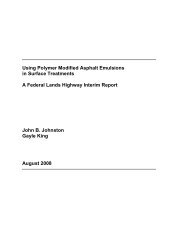Handbook for Bridge Inspections - TSP2
Handbook for Bridge Inspections - TSP2
Handbook for Bridge Inspections - TSP2
Create successful ePaper yourself
Turn your PDF publications into a flip-book with our unique Google optimized e-Paper software.
7.2.8 Measuring of Vertical Clearance<br />
Purpose<br />
Procedures<br />
Scope<br />
To measure the headroom <strong>for</strong> bridges crossing roads and the clearance<br />
<strong>for</strong> sh ips under bridges over the sea or other water.<br />
A headroom check may become necessary after rcasphalting or<br />
ot her changes to the roadway or, <strong>for</strong> example, after a heavy load<br />
has used the road. Depending on the bridge's design and the purpose<br />
of the measurements it may be relevant to take maximum and<br />
minimum headroom measurements.<br />
Acceptance Inspection<br />
Should the headroom of a new bridge not have been carried out at<br />
the building stage, then this should be done al the latest during the<br />
Completion SUlVey.<br />
Major Inspection - Special Inspection<br />
Headroom should be measured after rcasphalting or other works<br />
which can affect a bridge' s headroom.<br />
Equipment<br />
* Measuring tape<br />
* Telescopic measuring rod<br />
* Surveying equipment<br />
7.3 Adequate Materials<br />
Investigation - Concrete<br />
The following sections provide a description of the materials in vestigations<br />
which can be undertaken during the inspection ofbridges<br />
and their concrete elements.<br />
When evaluating the condition of a concrete construction it is<br />
important 10 remember that the different materials investigations<br />
should be viewed in relationship to one another.<br />
The local ising of materials investigations fo r coastal bridges is<br />
specificall y dealt with in Chapler 7.3.9.<br />
Refilling Test Holes..cuts<br />
Several of the materials investigations carried out on concrete<br />
require the drilling of holes or chiselling out cuts in the concrete.<br />
Procedural Code - 2 lays down a requirement in sllch instances<br />
that the holes/cllts be refilled. However, no guidelines have been<br />
given as to how th is should be completed. The foll owing procedures<br />
have there<strong>for</strong>e been recommended:<br />
Holes of a Diameter < 25 mm<br />
The hol es should be fi ll ed with grey paintable single-component<br />
polyurethane grouting or equivalent cement mortar,<br />
The holes should be completely fi lled using a tube connected to a
















